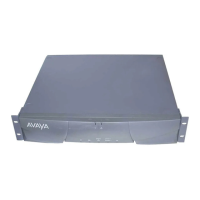Isolating and Repairing Packet-Bus Faults
Issue 1 May 2002
4-89555-233-143
Packet Bus maintenance software
Packet Bus maintenance software involves the usual set of MO error conditions,
tests, and alarms. These are described in ‘‘PKT-BUS (Packet Bus)’’ on page
8-1230. Since an EPN’s packet-bus fault can cause every BRI/ASAI endpoint and
its associated port and circuit pack to report faults, be careful to prevent a flood of
error messages overloading the system and interfering with traffic on the TDM
bus. When such a failure occurs, circuit-pack maintenance is affected in the
following manner:
■ In-line errors for the following MOs that indicate possible packet-bus faults
are logged but not acted upon: BRI-BD, PGATE-BD, PDATA-BD,
UDS1-BD.
■ In-line errors for the following MOs that indicate possible packet-bus faults
are neither logged nor acted upon: BRI-PORT, ABRI-PORT, PGATE-PT,
PDATA-PT, ISDN-LNK.
■ All in-line errors for the following MOs are neither logged nor acted upon:
BRI-SET, BRI-DAT, ASAI-ADJ.
■ Circuit pack and port in-line errors that are not related to the packet bus, or
that indicate a circuit pack failure, are acted upon in the normal fashion.
■ Periodic and scheduled background maintenance is not affected.
■ Foreground maintenance (for example, commands executed from the
terminal) is not affected.
These interactions allow normal non-packet system traffic to continue unaffected,
and they reduce the number of entries into the error/alarm logs. If the packet bus
failure is caused by a failed circuit pack, errors against the circuit pack should
appear in the error/alarm logs as an aid for fault isolation. The above strategy is
implemented when:
■ In-line errors indicate a possible packet bus failure reported by two or more
packet circuit packs.
■ A packet-bus uncorrectable report is sent from the Maintenance/Test
packet-bus port (M/T-PKT).
When such a failure occurs, a PKT-BUS error is logged. See ‘‘PKT-BUS (Packet
Bus)’’ on page 8-1230 for more detailed information.

